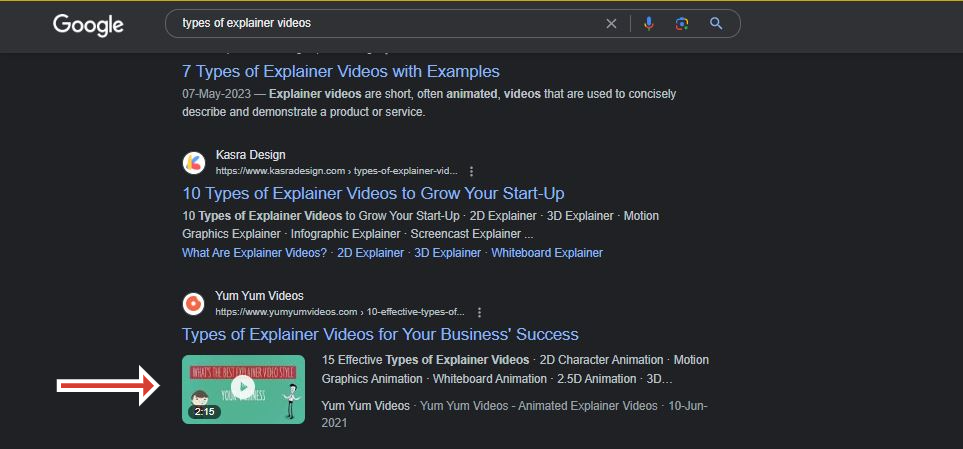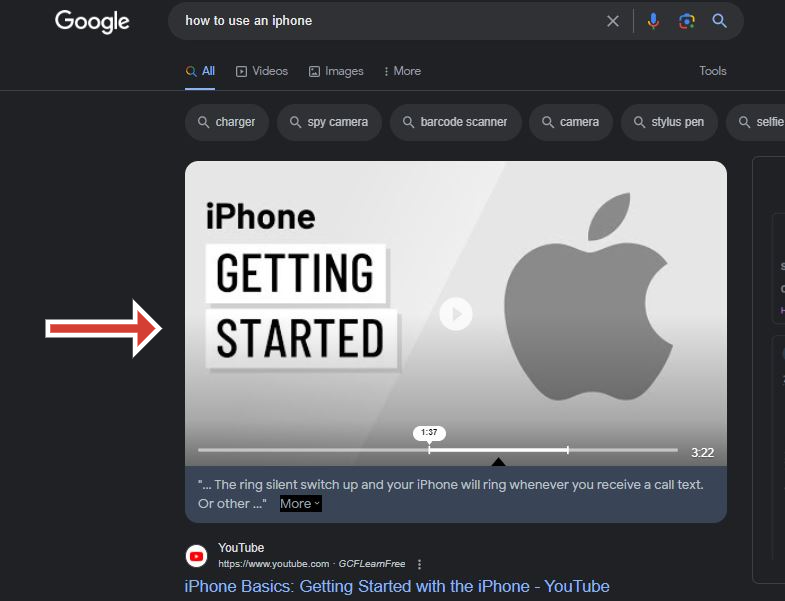6 SEO Areas That Will Improve Your Videos’ Performance

Videos are a key player in content marketing today, and for good reason.
Done right, they’re engaging and informative content pieces that can make complex topics easy to understand, delivering immediate value to your audience and improving your online profile.
But even the best videos will likely go unnoticed without the right SEO strategies to connect your content with the people you are trying to reach.
That’s where video SEO becomes essential to improve your videos’ performance.
In this guide, we’ll explore how SEO can boost your video’s visibility, focusing on six key areas that can enhance your video’s online profile and increase engagement.
Whether you are working with a short social media clip, an in-depth video explainer, or a behind-the-scenes brand video, these insights should help you get more out of your video content and expand your reach!

Keyword Research for Video Content Done Right
When doing keyword research to optimize your video content performance, you need to understand that the approach is slightly different from written content.
A great place to start is to brainstorm potential search queries. A free tool like Google’s Keyword Planner or YouTube’s search suggestions feature can be helpful in this phase as they can give you an idea of what viewers interested in your niche are currently searching for.
To take a step further, you can also leverage specialized video keyword research tools to further refine the quality and effectiveness of your video’s keywords.
Video-specific platforms like TubeBuddy or vidIQ are designed with this type of content in mind. They can provide a deeper understanding of popular keywords, their associated tags, and the competition you might face when targeting them.
It’s also worth mentioning here that popular search terms like “how-tos”, “tutorials“, “unboxing“, or “demo”, are directly tied to a particular type of video style or format, providing a user’s intent to find a specific type of video content and should be used whenever relevant.
Last but certainly not least, analyzing your competitor’s videos can be one of the most effective ways to gauge certain keywords’ potential success and viability. A deep dive into their titles, descriptions, and even the content of their videos can offer a wealth of keyword-related information.
It can even help you identify gaps in their content, which you can address in your videos to give you a competitive edge.

Video-specific Schema Markup Optimization
Schema markup, often simply referred to as “schema,” is a form of microdata that, when added to a webpage’s code, creates an enhanced description (commonly known as a rich snippet) that helps web crawlers better classify your content, improve search accuracy, and ultimately boost your content’s reach.
For video content, schema markup is pivotal in providing search engines with specific details about your video’s content and its potential relevance for search queries. This includes information like the video’s duration, its upload date, and even a brief content description.
It looks something like this:
<script type=”application/ld+json”>
{
“@context”: “https://schema.org”,
“@type”: “VideoObject”,
“name”: “Video Title”,
“description”: “Description of the video.”,
“thumbnailUrl”: “URL_to_thumbnail_image”,
“uploadDate”: “Date_of_upload”,
“duration”: “Video_duration_in_ISO_format”,
“contentUrl”: “URL_to_video_file”
}
</script>
When you provide this data, you’re essentially giving search engines a clearer, contextual understanding of your video, which can lead to more accurate indexing and, consequently, better visibility in search results.
Another standout benefit of using video schema markup as an optimization tool for your videos is the potential for displaying your content as a rich snippet in SERPs.
Rich snippets are enhanced search results that offer more information than standard listings. For videos, this could mean a thumbnail image of the video, its duration, and even a star rating.

These visually appealing search results can significantly improve click-through rates (CTR), as users are naturally more inclined to click on a search result that offers more information and appears more reputable.
Using Transcription and Closed Captions as Optimization Tools
At its core, video transcription refers to converting the audio dialogue portion of a video into written text. This textual representation of your video’s script can play an important role in further enhancing its SEO.
As advanced as they are, search engines still rely heavily on text to understand and index content. So, when you upload a transcription alongside your piece, you’re essentially giving search engines even more—keyword-filled—context about your video, making it easier for them to determine its relevance to specific searches and potentially leading to better rankings and, consequently, more visibility for your content.
On the other hand, closed captions are timed text overlays that appear on screen, synchronizing with the video’s audio. While they serve an SEO purpose similar to transcriptions, their primary role is to promote accessibility.
Any experienced video agency worth its salt will tell you that accessibility can greatly impact your video’s performance. For viewers who are deaf, hard of hearing, foreign to your video’s language, or those who routinely watch videos in silent play, closed captions are indispensable.
They ensure that the content is accessible to a broader audience while also contributing to your video’s SEO optimization.

Using Dedicated Landing Pages for Video Embedding
A dedicated landing page for a video is essentially a standalone web page crafted specifically for that piece. Instead of embedding your video amid other content or on a generic page, you give it its own space, free from distractions and optimized to synergize with your content. A focused approach that offers several advantages.
From an SEO perspective, a dedicated landing page allows for targeted optimization. You can craft meta tags, URLs, and content that align perfectly with the video’s topic and intent. This specificity can lead to better search engine rankings, as the content is made highly relevant to specific search queries related to the video topic.
Structurally, a dedicated page also offers a fully customizable clean slate, allowing you to design the user experience around the video and potentially leading to better viewer retention rates. Without competing content or distractions, viewers are more likely to watch the video in its entirety and engage with any accompanying call-to-actions or supplementary content.
Plus, having a unique URL for each video simplifies sharing and promotion. Whether on social media, email campaigns, or other marketing channels, sharing a direct link to the video’s landing page ensures that your audience gets right to the content without any detours.

Backlink Building for Videos
Earning quality backlinks for your video content means driving potential viewers to the places where you host said content.
Firstly, focus on creating share-worthy content. This might sound like a given, but informative, entertaining videos that evoke strong emotions are more likely to be shared and embedded by other websites and blogs.
Always craft and edit your videos in ways that offer genuine value to the viewer, as that makes it more likely they’ll be used by others as a resource or reference.
Then, you can focus on collaborating with influencers or industry-relevant content creators. By partnering with them, either in the video creation process or by seeking their endorsement, you tap into their audience and credibility. Such collaborations often lead to shares, mentions, and, yes, backlinks that improve your video’s overall reach and performance.
Next up, encourage embedding! When another website embeds your video, it’s akin to them giving you a backlink. The more places your video appears, the broader your reach and the stronger your backlink profile.
Lastly, don’t shy away from traditional link-building strategies. Reach out to websites or blogs that might find your video content relevant. Offer guest posts that can naturally incorporate your video. Participate in forums or communities where sharing your video adds value to discussions.
Social Sharing and Promotion
Promoting your videos across social platforms like Facebook, Twitter, Instagram, and LinkedIn can improve your overall SEO push, leading to other myriad benefits.
In essence, every share or tag amplifies the reach of your content, potentially introducing it to audiences beyond your immediate followers. This extended visibility can translate into more clicks, directing traffic to your website or the platform where your video is hosted.
And, as we know, increased website traffic, especially from diverse sources, is a positive signal for search engines.
Moreover, as your video’s visibility increases on social media, it can elevate your brand’s authority and recognition. Over time, this can lead to more organic searches for your brand or specific content pieces, further boosting your SEO performance.
Lastly, a video that resonates with viewers and sparks discussions can attract the attention of industry experts, bloggers, and journalists. They might reference or share your content, earning you those coveted backlinks that search engines love.
In Short
While creating compelling videos is vital, it’s also the starting point.
To truly make your content shine, integrating SEO strategies is essential. In this guide, we’ve highlighted key areas—from keyword research to social sharing—that can elevate your video’s visibility and engagement.
Now, it’s your turn. Implement these insights, track your progress, and watch as your videos reach and resonate with a broader audience.

